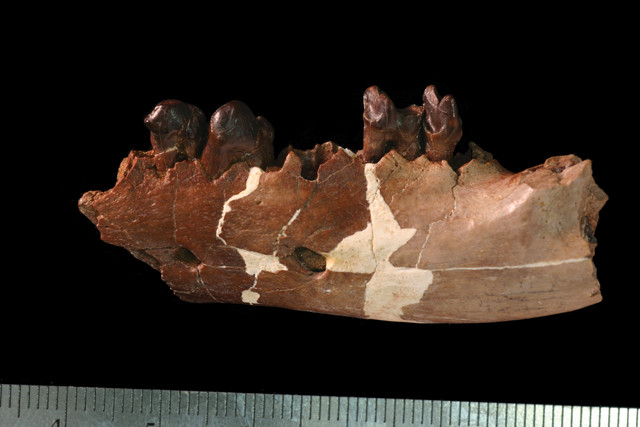
by Lucas Joel Tuesday, September 20, 2016

This jaw fragment is part of a specimen of Didelphodon, a cat-sized marsupial predator that went extinct during the Cretaceous-Paleogene mass extinction. Credit: Nick Longrich.
Mammals, unlike the remaining nonavian dinosaurs and many other animals, are thought to have fared relatively well through the massive meteorite impact and protracted volcanism at the end of the Cretaceous 66 million years ago. After the extinction, mammals went on to dominate terrestrial ecosystems. But new research indicates that mammals might have taken a bigger hit than paleontologists have realized: Instead of about 75 to 85 percent of species going extinct, as prior studies suggested, it looks like about 93 percent of all mammal species may have gone extinct during the Cretaceous-Paleogene (K-Pg) extinction.
The problem with the earlier estimates is that most studies that have reconstructed what happened to mammals across the K-Pg boundary have only looked at limited geographic regions, says Nick Longrich, a vertebrate paleontologist at the University of Bath in England and lead author of a new study published in the Journal of Evolutionary Biology. But “the big picture looks different than the local picture,” Longrich says. “Traditionally, people have picked one little area and focused on it, but we collected data … from all over North America.”
When researchers studying and quantifying the extinction focus only on specific localities, Longrich says, they run the risk of not accounting for species that lived outside that area, and whose geographic range was limited but that also went extinct along with more common mammals.
Longrich and his co-authors compiled mammal fossil occurrence data from across the K-Pg boundary from a variety of different previous studies. Based on this more holistic view, they found that Earth’s mammalian fauna “lost more than 90 percent of its diversity,” Longrich says. However, it “then gained that back, and then doubled what it was before [the extinction] within 300,000 years, which, geologically, is not a long time,” he says. “This is an extraordinarily rapid recovery,” and one in which there might have been almost no delay between the asteroid impact and when mammals began diversifying.
The new study is novel in that it “shows that the extinction might have been a little more intense than what people thought,” says David Grossnickle, a graduate student studying paleontology at the University of Chicago who was not involved in the new work.
At what tempo the mammalian recovery proceeded, though, is still up for debate, Grossnickle says. Whether mammals recovered and began diversifying quickly, as Longrich and his colleagues suggest, or whether “it took mammals a little time [perhaps closer to 1 million years, according to other recent estimates] to actually recover, and then start to radiate” is unclear, he says. Part of the reason for this discrepancy goes back to the fact that paleontologists aren’t all looking at the same data. “We’re not all looking at the same groups [of animals] at the same time,” Grossnickle says, which can lead to different interpretations with respect to the timing of recovery.
Another pattern Longrich and his team spotted was that, during the mammals’ recovery, distinct populations became separated. Longrich likens what his team found to the hypothetical aftermath of a future extinction that leaves rats, cockroaches and pigeons living: You might expect that each of them would spread out, filling ecological niches globally, he says, “but instead what we have is that the rats dominate in one place, the pigeons dominate another place and the cockroaches” yet another.
Before the K-Pg extinction, many mammals were common and widespread, Longrich says. Afterward, though, mammalian populations fractured. Mammals that had been more widespread going into the extinction stood a better chance of surviving than those confined to specific areas, Longrich says. “You’re more likely to survive if you don’t have all your eggs in one basket.” However, there was also an element of luck involved: Both Didelphodon, a marsupial, and the rodent-like Mesodma were common and widespread, for example, but while Mesodma survived through the extinction, Didelphodon did not. And the species that went on to dominate disparate locales were ones that were “lucky” through the extinction more so than those that may have been best-adapted to each particular environment, he says.
Grossnickle says that continuing work needs to further examine the impact that other forces, like food availability, had on mammalian diversity through the K-Pg extinction. For example, flowering plants, which evolved toward the end of the Cretaceous, had become a major mammalian food source, he notes, adding that it’s possible “mammals’ evolutionary trajectories are more linked to the availability of the food that they are eating” than has been realized. An “ecosystem-wide” perspective would combine data on different mammal and plant groups, he says, and could help clarify mammalian diversification patterns across the K-Pg boundary.
© 2008-2021. All rights reserved. Any copying, redistribution or retransmission of any of the contents of this service without the expressed written permission of the American Geosciences Institute is expressly prohibited. Click here for all copyright requests.